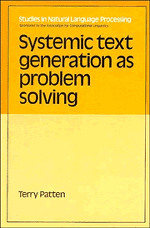Book contents
- Frontmatter
- Contents
- Dedication
- Preface
- 1 Introduction
- 2 Background I: AI problem solving
- 3 Background II: systemic grammar
- 4 The conflation
- 5 The formal model
- 6 The implementation
- 7 Related work in text generation
- 8 Conclusions
- Appendix A OPS5 tutorial
- Appendix B Sample texts
- Appendix C Excerpts from the grammar
- Notes
- Bibliography
- Index
- Frontmatter
- Contents
- Dedication
- Preface
- 1 Introduction
- 2 Background I: AI problem solving
- 3 Background II: systemic grammar
- 4 The conflation
- 5 The formal model
- 6 The implementation
- 7 Related work in text generation
- 8 Conclusions
- Appendix A OPS5 tutorial
- Appendix B Sample texts
- Appendix C Excerpts from the grammar
- Notes
- Bibliography
- Index
Summary
This chapter will describe the first implementation of the Systemic Linguistic Approach to Natural-language Generation (SLANG-I). SLANG-I has been implemented as a production system using the production language OPS5. Since many OPS5 rules appear in this chapter, a short introduction to OPS5 has been provided in Appendix A.
This chapter is divided into five sections. The first is an overview of the system as a whole. It will provide high-level descriptions and explanations for the mechanisms used in the implementation. The second section is a detailed description of the System Network – OPS5 Rule Translator (SNORT) which outputs the grammar in the form of OPS5 production rules that can be used by SLANG-I. The text-generation system itself–SLANG-I–is described in detail in the third section. The fourth and fifth sections look at the limitations of this implementation and some possible alternatives respectively. Finally, a summary is given.
Overview
The purpose of this section is to provide a high-level overview of SNORT and SLANG-I before getting down to details in the next two sections. To a large extent this is made necessary by the interdependence between these two components. It is impossible to motivate the output of SNORT before explaining to a certain extent how SLANG-I works, and similarly SLANG-I cannot be explained before it is understood how the grammar is represented in OPS5 production rules. This section consists of four parts: first, a presentation of the abstract architecture of SLANG-I; second, a discussion of the OPS5 productions representing the systemic grammar; third, a description of the data structures used by SLANG-I; and fourth, a brief look at the control strategy used to coordinate the text-generation process.
Information
- Type
- Chapter
- Information
- Systemic Text Generation as Problem Solving , pp. 104 - 132Publisher: Cambridge University PressPrint publication year: 1988
